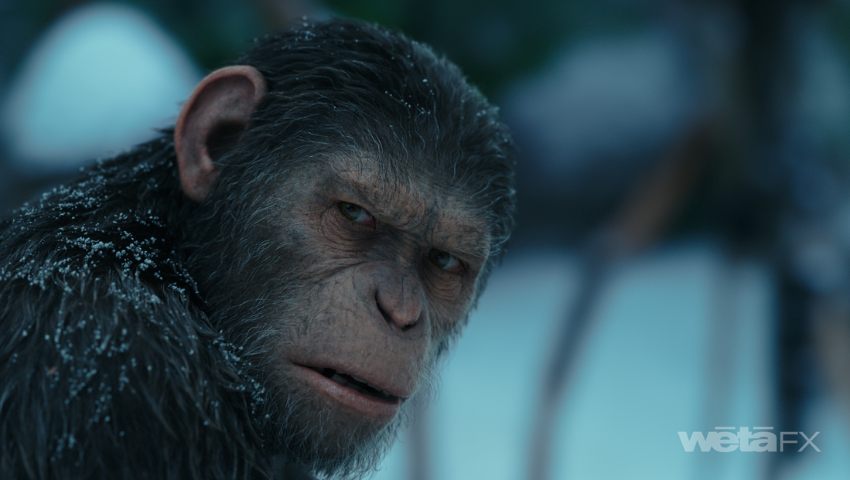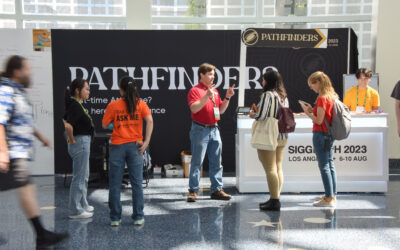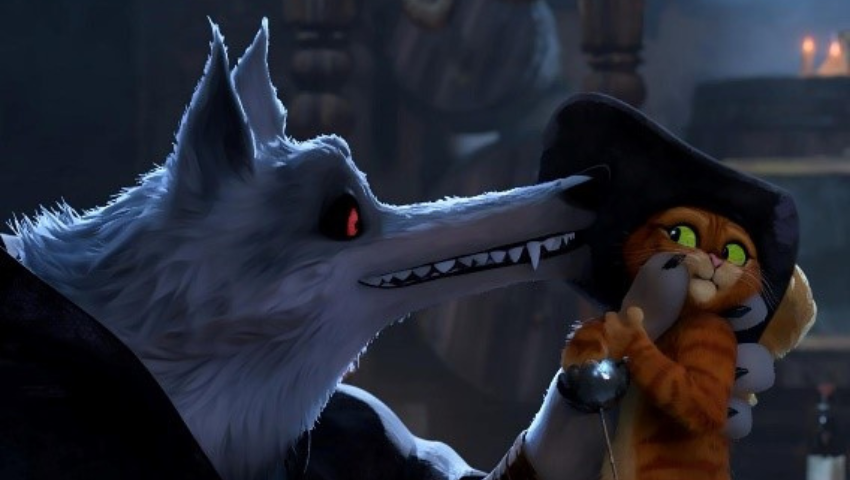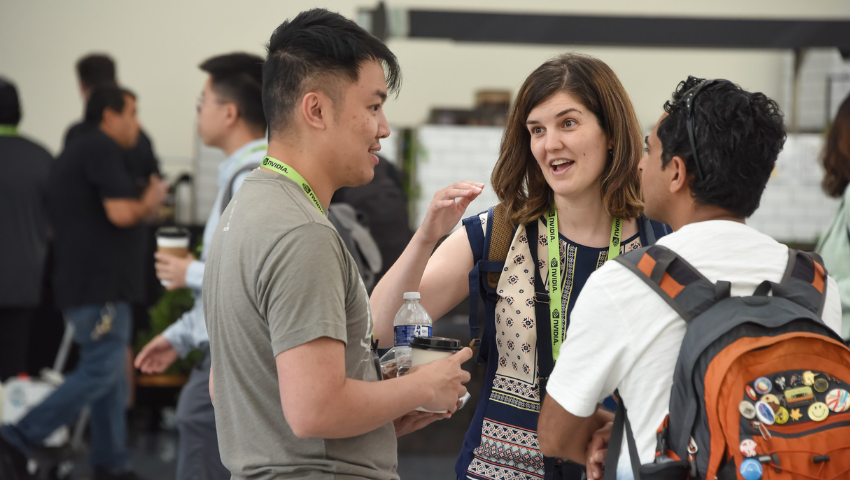Image Credit: © 20th Century Studios
We sat down with Paul Story, Phillip Leonhardt, Erik Winquist, Aidan Martin, and Kevin Smith to discuss their SIGGRAPH 2024 Production Session “Monkeys, Chimps & Gorillas: Wētā FX’s (r)Evolutionary Work With Primates.” This riveting discussion offers you a behind-the-scenes look at how the iconic primates we have grown to love in cinematic history are brought to life.
SIGGRAPH: Share some background about your SIGGRAPH 2024 Production Session, “Monkeys,
Chimps & Gorillas: Wētā FX’s (r)Evolutionary Work With Primates.”
Paul Story (PS): I’ve been fortunate enough to work on some of Wētā FX’s iconic primates over the last few decades. I was an animation sequence lead on “King Kong” in 2005, and then went on to be animation supervisor for Caesar on “Dawn of the Planet of the Apes”, King Louie and his crew in “The Jungle Book”, and now Noa and his clan on “Kingdom of the Planet of the Apes”, so I’ll be exploring how our approach to apes has developed across shows.
Phillip Leonhardt (PL): I’ll also be exploring our work on the “Apes” franchise, providing an overview of the technology advancements we employed for “War for the Planet of the Apes”, coming off the back of “Dawn” and “The Jungle Book”. This will cover hardware and software rendering innovations, while looking at how we overhauled our shading and lighting pipeline. From there, we’ll move onto our new kingdom, introducing a whole new cast to the “Apes” franchise many generations after Caesar’s reign. State-of-the-art facial capture technology has breathed new life into our ape family and their foes, and instead of snow and avalanches, nature this time decided to unleash a tidal wave of river rapids and silo floods for the final act, all realized using the latest tech advancements from Wētā’s in-house water simulation framework.
Erik Winquist (EW): It’s an interesting vantage to have in 2024, given how many digital primate characters Wētā has created over the years. I was the overall visual effects supervisor for “Kingdom of the Planet of the Apes”, and I was a VFX supervisor on the previous three “Apes” films as well, and — like Paul — I’ve been at Wētā since before “King Kong” in 2005. I’ve been around long enough to have witnessed the evolution of both our knowledge about primates and our tools and processes that successfully bring them to the screen as compelling characters that audiences can empathize with.
Aidan Martin (AM): We had to take a different approach for creating “The Umbrella Academy’s” loveable and grandfatherly chimpanzee Pogo, as he’s more human-like than our previous primates. Over the three seasons that I was animation supervisor on the show, Pogo went through multiple iterations, and he also required three actors to bring him to life; onset, voice, and mocap — so I’ll explore the challenges and resolutions for tackling a primate character as sophisticated as Pogo.
Kevin Smith (KS): I was the VFX supervisor on 2021’s “Godzilla vs. Kong” and this year’s “Godzilla x Kong: The New Empire”, so I plan on talking about how the Legendary “Godzilla vs. Kong” films fit into Wētā’s monkey-making history with a brand-new cast of apes.
SIGGRAPH: From King Kong to Caesar to Pogo, how has your team evolved and improved the
process of bringing these iconic primates to life?
PS: From my experience, with each new film we’ve learned new ways to capture performances and gather more data. Whether it’s from partial video reference or full motion capture, it’s all reference grounded in reality that brings a character to life.
KS: At Wētā, one of the best, and most challenging, things is the relentless pace of progress. There’s nothing that can’t be improved upon, so it is just a question of “what can we make just a bit better this time around?”
PL: Well, the team’s age (and wisdom) evolved dramatically since 2005’s “King Kong”, and the experience gathered from every project informs where we might steer the technology train next. We embrace the fact that hardware continues to become more potent, which opens opportunities we may not have had on our last project. Integrating new tech and workflows to build a more sophisticated pipeline and better tools for artists to use is an ongoing adventure — whether that’s motion capture techniques, creature rigging, animation workflows, or rendering paradigms. Over the last 20 years, the team’s confidence and skillset grew together strong (“Kingdom” pun intended) to become a better ape every time a new one shows up on screen.
AM: For Pogo, our distinguished gentleman chimpanzee in “The Umbrella Academy” series, we took what we knew from the “Apes” films and boiled it down to its key components so we could develop an episodic approach to how we do apes. This included ape anatomy, movement styles, and how we applied the Facial Action Coding System- (FACS) based facial system
EW: A very visible part of the advancements has been on the capture side. While “King Kong” utilized motion capture to record Andy Serkis’ body movements for “Kong”, the facial capture part of the equation was in a very primitive state, requiring Andy to perform as Kong for a rigid capture rig, separate from his body. The R&D done for the first “Avatar” film, which came on the heels of “Kong”, changed all of that and by the time “Rise of the Planet of the Apes” came our way, Andy could play the role of Caesar as a singular performance, in a set outside on location, and we could capture that performance and translate it into a digital ape. Hardware and technology improvements have continued ever since, resulting in even greater fidelity in the data we have to work with, but the basic principles remain the same. The other part of the recipe is, of course, what we do with that data. “King Kong” (2005) was the first time we started using a FACS-based animation puppet for the character, and that has continued to be the way we rig primate faces to this day. Along the way, every aspect of the visual effects pipeline has seen massive improvements in computational performance, tissue simulation, rendering technologies, shading approaches, compositing advancements … it’s all been put to great use in creating incredibly lifelike characters.
SIGGRAPH: Were there any barriers you encountered during the process of introducing “Godzilla x Kong” into the Wētā family this year? If so, how did you overcome those challenges?
KS: For Legendary’s “Kong” films, scale has been our biggest challenge. The Titans are so big that it makes achieving believability that much more difficult. For us, we had to move away from our typical pipeline to account for size, so I’ll be exploring that more in this session.
SIGGRAPH: What is your favorite part about the work you do?
PS: I really enjoy the process of discovering the character of the creatures we work on. Each has their own personality and style, so each film experience brings something new and fresh, and I’m always learning.
KS: I love movies, and I love being able to be a big part of helping the director tell a story and make a film that people love.
PL: Like Kevin said, I love the creative collaboration with the team and filmmakers, to craft solutions and push boundaries. But most of all, I love tricking audiences into believing that the illusions we create on the big screen are genuinely real. If my work contributes to people having a good time in theaters or in front of the TV, escaping their everyday hustle for just an hour or two, wow! Nothing better than that!
AM: For me, it’s bringing a living, breathing character with thoughts and feelings and subtext to life.
EW: In a time when giant blockbuster films get spread across many different visual effects facilities, we’ve been lucky with these films in that in many cases, we’ve had very close-knit relationships with the directors. In the case of the “Apes” films, Wētā has created all the visual effects work in them. When you get to be that tightly involved in the movie-making process with a filmmaker, it is a very creatively satisfying place to be; you’re deeply part of the process and not just executing a brief for a client.
Internally, working with our internationally diverse team of hugely talented artists is a gift. Once the machine gets cranking, every day brings a whole new batch of insanely beautiful work to marvel at. I love it.
SIGGRAPH: Your team has proven that the approach to these loveable characters continues to evolve. What can moviegoers expect in future films?
EW: I would hope that the technology continues to fade further into the background for moviegoers, that they really don’t question what they are watching is a 100% real performance, captured by a camera and projected onto a giant screen. We’re at a point now where there just isn’t a limit to the imagery that can be created, so screenwriters will continue to raise the bar for both giant spectacles, but also the most affecting intimate moments between characters on screen. I’m looking forward to it!
PS: We’re always finding new ways to tell stories through our characters. Moviegoers will see more detail in our characters, as we find new ways to tell stories through their performances.
PL: We all very much hope that Noa and his clan continue their adventures in the future. The universe just opened up for him with so many stories one could tell. And of course, technology will continue to play a role in optimizing our craft, so please expect every future creature to strive toward becoming an even better one in the future.
KS: We’ll just have to see what the filmmakers challenge us with for the next one!
SIGGRAPH: What do you hope the SIGGRAPH 2024 audience takes away, personally or professionally, from your presentation?
PS: I hope the audience can see or find something new that might apply to, or inspire, their own work in some way, primate or not.
KS: Just what Paul said — I hope we can pass on at least some information about the work that we’ve done over the years that can help someone do the same kind of work down the road.
PL: A love for apes (both the movies and the animals) and a broad understanding of what it takes to bring a digital, talking ape to life on the big screen.
AM: That it’s not the latest tech and AI that produces believable characters, it takes an army of artists making creative choices about every little aspect to bring these characters to life.
EW: With enough distance from something, it can be valuable to look back and see how far one has come. I’ve found it to be pretty wild that work that was heralded at the time as so impressive and photoreal can sometimes look quaint compared to recent imagery, which has had the benefit of years of experience and technological improvements. It makes me excited to think about where things will be in another 10, even 20, years, and I hope that excitement is what this presentation generates in the audience.
SIGGRAPH 2024 is right around the corner. Don’t miss out on this thrilling Productions Session presentation along with a wide variety of computer graphics content presented in Denver and virtually. Don’t let this opportunity slip by, register for SIGGRAPH 2024 today.

Paul Story has worked as an Animation Supervisor on a host of critically acclaimed shows including The Adventures of Tintin, Iron Man 3, Avengers: Infinity War, The Rings of Power series, and the Planet of the Apes trilogy. Most recently, Paul has wrapped on the new era of Apes; Kingdom of the Planet of the Apes. Paul has been a part of Wētā FX since Peter Jackson’s The Frighteners in 1996. Starting as a Rotoscope Artist, Paul was inspired to pursue a career in animation after watching The Frighteners’ ‘Reaper’ come to life. After four years in Wētā’s Creatures department, where he helped develop skeleton and muscle designs for Gollum and the troll in The Lord of the Rings: The Fellowship of the Ring, Paul moved into animation to help animate Gollum, fellbeasts, and trolls in The Lord of the Rings: The Two Towers. Paul went on to lead sequences in The Lord of The Rings: The Return of the King, and King Kong, before progressing to Animation Supervisor on films including Dawn of the Planet of the Apes and Jon Favreau’s The Jungle Book.

Phil Leonhardt joined Wētā FX in 2005 to work as a Senior Compositor on Peter Jackson’s King Kong. He subsequently worked on an array of films, such as X-Men: The Last Stand, Fantastic Four: Rise of the Silver Surfer, The Water Horse, The Day the Earth Stood Still, and The Lovely Bones as well as working as a Lighting TD on James Cameron’s Avatar. Ridley Scott’s Prometheus saw Phil take on supervisory responsibilities, since then he has led CG and VFX teams to help deliver Man of Steel, The Wolverine, and Furious 7. In addition to his work on Dawn of the Planet of the Apes, Phil led the VES Award-nominated Prison Camp sequence for War for the Planet of the Apes. Phil led the Iron City team on Alita: Battle Angel before joining the other VFX Supervisors on Avengers: Endgame and She-Hulk: Attorney at Law. Most recently, Phil has been one of Wētā FX’s Sequence Visual Effects Supervisors on Kingdom of the Planet of the Apes. Alongside the film projects, Phil has led a Research & Development team building paint, roto and comp tools to manipulate and re-create plate photography. He helped design in-house FX library tools, lighting tools for our Physlight pipeline, and deep compositing workflows, particularly in the field of volumetrics. In addition to his VES nomination, Phil has been nominated for two HPA awards for Maze Runner, The Death Cure, and Man of Steel. Before joining Wētā FX, Phil worked on the first two Harry Potter films at Cinesite in London.

Erik Winquist is an Academy® and BAFTA Award nominated Visual Effects Supervisor. He has recently wrapped on the new era of Apes films: Kingdom of the Planet of the Apes, leading a team of over 1,000 artists and crew. Erik came to Wellington in 2002 as a compositor on The Lord of the Rings: The Two Towers. That six-month period made a lasting impression and this year he celebrates 20 years at Wētā FX. His first supervisory roles at the studio were on I, Robot (2004) and Peter Jackson’s King Kong (2005), where he supervised the jungle sequences, nominated for a VES Award for Compositing in 2005. Erik has an enduring interest in developing on-set technologies for visual effects. He has been closely involved with the integration of Wētā FX’s cutting-edge performance capture technology into the production workflow, bringing digital performances into physical sets. More recently, he led an internal research project in the form of a short film called Lancaster, which experimented with the potential of LED virtual production workflows in a dynamic, fast-paced scene. Erik’s film credits include Dr Strange in the Multiverse of Madness (2022), Avatar (2009), Rampage (2018), and the Planet of the Apes trilogy. His contribution to Dawn of the Planet of the Apes (2014) was recognised with an Academy Award® nomination for Best Achievement in Visual Effects and a BAFTA nomination for Best Special Visual Effects.

As Animation Supervisor at Wētā FX, Aidan manages the creative and technical execution of CG characters across animation, motion editing, and performance capture. Aidan specialises in creating emotive facial performances for performance-capture shows, such as Wētā’s beloved Pogo in The Umbrella Academy, for which he was nominated for a VES Award in 2020 and won a VES Award in 2023. With 19 years of professional experience, Aidan has been a part of the animation team on multiple award-winning shows. He joined Wētā FX in 2013 to work as an Animator on The Hobbit: The Desolation of Smaug, and went on to be Lead Animator for the sweet and earnest performance of The BFG, Animation Supervisor on War for Planet of the Apes, and a Senior Animator on Avengers: Endgame. Most recently Aidan was Animation Supervisor on the Oscar-winning short animated film War is Over! Inspired by the Music of John and Yoko, and he has just wrapped as Animation Supervisor on Kingdom of the Planet of the Apes. Aidan holds a Bachelor of Arts in Computer Mediated Art and a Diploma in Animation. In 2018, he was nominated for a VES Award for Outstanding Animated Character in a Photoreal Feature for his contribution to Bad Ape from War for the Planet of the Apes.

Originally from Los Angeles, California, Kevin Smith arrived at Wētā FX in 2000 to work as a Shader Writer for The Lord of the Rings: The Fellowship of the Ring. Kevin was heavily involved in the look development of Gollum before moving onto The Lord of the Rings: The Two Towers as a 3D Sequence Lead. He recently wrapped as Wētā FX’s Visual Effects Supervisor on Godzilla x Kong: The New Empire. In 2003, Kevin joined Sony Pictures Imageworks, working in varying roles on projects such as The Matrix Revolutions, The Chronicles of Narnia: The Lion, The Witch and The Wardrobe and Beowulf. James Cameron’s Avatar brought Kevin back to Wētā FX in 2007. Kevin was also Digital Effects Supervisor on Steven Spielberg’s The Adventures of Tintin. No stranger to working with titans, Kevin was VFX Supervisor on Godzilla vs. Kong (2021), and Monarch: Legacy of Monsters (2023. Kevin was also VFX Supervisor on Zack Snyder’s Justice League. For Mortal Engines he supervised the creation of the CG environment Shan Guo, the third act’s mountain city location, along with sequences in the final battle. A Supervisor on Guardians of the Galaxy Vol. 2 he was instrumental in the creation of Planet Hollow. For fan favourite holiday movie Krampus, Kevin was onset VFX Supervisor, working directly with the client from planning and pre-production through to final realisation and delivery. He was also second-unit on-location VFX Supervisor on The Hobbit: An Unexpected Journey and Sequence VFX Supervisor on the subsequent two films in the trilogy. Kevin studied Physics and Computer Science at Case Western Reserve University in Cleveland, Ohio.



